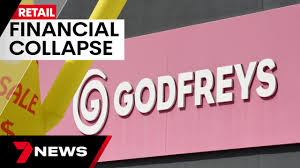Earlier this year, iconic – but clearly not iconic enough – Aussie retail brand Godfreys entered administration. After several months of trying, a buyer for the business could not be found and the decision was made to wind the business down entirely, a process expected to finish shortly. The death of Godfreys adds to spiking business failure rates, which have doubled over the last couple of years, according to Creditorwatch.

Fun fact – the businesses with highest rate of failure are cafes and restaurants, whereas the third lowest is the financial and insurance services category.
For the benefit of younger readers, Godfreys was a national retail chain that specialised in one product only – vacuum cleaners.
Founded in the 1930s, Godfreys strategy for building a brand was very much out of the pre-internet playbook – price discounting, category expertise, and some of the most memorable product demonstration television commercials ever to grace Australian tv screens (34-inch screens and built like a tank, thank you very much).

These ads largely featured their CEO – sporting a killer comb-over –who would first give you a full run down of features in the way one might do when selling a car (the on-board tool set, the smooth-running wheels, sturdy body etc) before coming to his party trick for the ages – the bowling ball test! This would involve demonstrating the awesome suction of the product in question (for example the Wertheim 1300, made in Europe, no less) by sucking and holding up a 16lb shiny black bowling ball.


So with a national chain of stores, deep expertise in vacuum cleaners, and memorable tv advertising, how could you possibly go wrong?
You could easily pick a number of individual factors:
- They bet big on bricks and mortar stores when everyone was starting to buy online
- The wealth of online vacuum cleaner reviews, manuals, and demonstration videos meant that ‘vacuum cleaner experts’ didn’t even get to be replaced by AI, they are extinct already
- They were slow to embrace technological innovation and trends like space-saving robot and stick vacuums, which are popular with apartment dwellers
- They refused to stock Dyson, one of the most popular – and disruptive – vacuum brands of the last 20 years or so.
But at a higher level, Godfrey’s problem was they didn’t change with the times, or more accurately, with the changing expectations of their consumers, who today are more likely to buy online from mega retailers like Amazon or JB Hifi, or go direct to Dyson.
It’s not as if the vacuum cleaner category is a dead end. On the contrary, increasing urbanisation, and the ‘Dyson effect’ (disruptive innovation that people are happy to pay for) means that the category is booming. Revenue from Australia’s vacuum industry is forecast to hit $450 million this year, according to Statista, with an annual growth rate of 3.7 per cent over the next four years. Dyson is booming also, with their V15 Detect going for nearly $1700!

Now at this stage it is tempting to throw out the line attributed to Einstein, that about the definition of insanity being ‘doing the same thing but expecting a different result’. Did Godfrey’s keep doing the same thing, and expect their sales to turn around?
It turns out that in the realm of quantum theory, what Einstein describes as insanity – same thing, different result – is actually the way the world works. In quantum mechanics you can do the same thing many times and get different results. Indeed, that is the premise underlying great high-energy particle colliders. In those colliders, physicists bash together the same particles in precisely the same way, trillions upon trillions of times. Are they insane? Perhaps not.

Some providers keep treating advisors the same way
All of this brings me around to the financial advice landscape in Australia. My suspicion is that many product providers aren’t behaving insanely – they keep doing the same thing, but only expect the same result. And to be honest, that’s still a problem.
Some people use Hayne as the marker of major change in advice, but the die was actually cast 5 years earlier with the FOFA reforms. These were the changes that basically told advisors ‘you need to change’.
And to their credit, change they did. They’ve become more client centric, better educated, and more compliant. They manage to stay abreast of an ever-expanding product universe, increasingly complex regulations, and a continuously volatile stock market, against a backdrop of more demanding customers.
They’ve also become a lot more tech savvy, and a lot more entrepreneurial, in line with the fragmentation of licensees that sees the majority of advisors now working for micro AFSLs or boutiques.
Advisors have changed, and they expect providers to change also, especially in the way they engage advisors– that includes the channels they use, the way they communicate, and the content they produce.
But I’m not sure everyone got the memo.
From my perspective, many providers are still using old-fashioned tactics, and having one-way conversations with advisors. Advertising, roadshows, and boardroom lunches are the channels through which dull, overly technical, compliance focused messages are delivered.
There is no two-way conversation at all.
But advisors expect more. They don’t want to be dictated to, they want to have a say in product development, they want simpler documents and processes.
They want to be heard.
There are so many things I could point to, but for me the Target Market Determination (TMD) is as good as any. ASIC themselves have said that the TMD is not intended to be a customer facing document, and yet many providers have injected it into customer facing processes, treating it the same as a PDS. It’s lazy lawyering, and not helpful to advisors who are also small business owners, and for whom extra compliance steps have a real bottom line impact.
The Ensombl community – closing in on 9,000 members – is the place advisors come to be heard. By their peers, and by product providers. We are certainly grateful to those forward-looking corporate partners who have embraced change and now look to engage advisors on advisor’s terms.
The best bit is that these partners enjoy the rewards, in the form of a 45% uplift in response rates to their content.
We call it the co-creation dividend, and we’d love to tell you about it sometime.
Just reach out for a chat.

